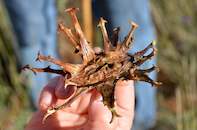Devil’s claw is a geophyte that survives in the arid regions of the Kalahari by storing water and nutrients in underground tubers of up to 25 cm long and 6 cm wide.

The two species – Harpagophytum procumbens and Harpagophytum zeyheri are found in Namibia, Botswana and South Africa, as well as in Angola, Zambia, Zimbabwe and Mozambique (H. Zeyheri). The plant has sprawling stems and produces a purple-pink trumpet-shaped flower that blooms for one day only in the summer - November to April.
In 2002, the first successful plantations in South Africa and Namibia were established and 250 000 seedlings in 2003 yielded a 40 ton harvest in 2004. Currently Namibia produces the bulk (90%) of exported product.
In South Africa, devil’s claw is found in Limpopo, Northern Cape (limited harvesting) and North West provinces (commercial harvesting). Devil’s claw is most abundant in grasslands where it prefers deep well-drained sandy soils in areas where the natural vegetation has been cleared, like roadsides or waste lands.
The plant is propagated by seeds or planting secondary tubers. Growing wild, the plant is ready for harvest after four years. Harvesting involves digging (1-2m deep), removing, slicing and drying of the tubers.
Devil's claw is a protected plant in South Africa, Botswana and Namibia. This means that it is illegal to dig it up or harvest even one plant, without a permit from the various departments of nature conservation.
Benefits of Devils Claw
The name alludes to the hook-like appearance of the fruit (‘thorns’). The Southern African Khoisan and Bantu-speakers have used devil’s claw for indigestion, blood diseases, fevers, sprains and boils. The best applications were drinking it as a tea or eating the powdered root, but it was also applied to the skin.
Today, the medicine is available in the form of pills, capsules, teas, tinctures and creams. The first Westerner to learn about devil’s claw was a German, G.H. Mehnert, who learnt about this plant from the San and Nama people in Namibia in 1904. (Today Germany sees huge imports of this herb).
The black fibre of the “claw” is used in the weaving of baskets and the dried seeds can be peeled and eaten. The young fruit can be cooked as an okra-like vegetable.
Modern applications of the plant include a non-steroidal anti-inflammatory and natural pain relief for arthritis - it works in a manner similar to cortisone but without the side effects. There are, however, some contradictions - for example, devil’s claw is contraindicated for diabetics and people with duodenal and gastric ulcers.
Medical Disclaimer
Information is for educational and informational purposes only and may not be construed as medical advice. The information is not intended to replace medical advice or treatment offered by healthcare professionals.By Marinda LouwFor bulk or Devils Claw export enquiries please use the enquiry link below.